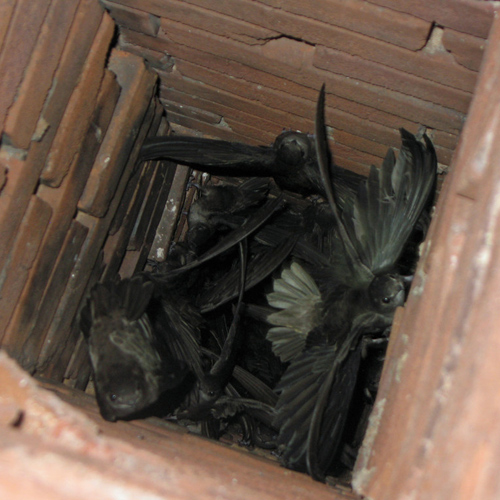When asked to think of warmer months, the sound of birds chirping probably comes to mind. The sound, when heard out in nature, can be quite soothing. However, one can imagine how hearing those same sounds coming from the inside your chimney could get old quickly. Let’s face it—these sounds aren’t music to everyone’s ears. One possible culprit for these noises in your chimney is the “flying cigar” or, as it’s more commonly known, the chimney swift.
 These tiny and extremely adaptable birds are quite common across much of eastern North America from southern Canada east of Saskatchewan, south through Texas and to the Atlantic seaboard. Long before European settlement of North America, chimney swifts historically nested and roosted in hollow trees, caves, and on cliff faces; as these nesting areas were slowly removed because of westward expansion and clearcutting, the birds were forced to seek comparable nesting locations elsewhere. They now prefer nesting in chimneys and other artificial sites, including open wells, air vents, garages, silos and barns. The main requirement for a desirable location is shade from sunlight and the elements. As such, one can easily see why chimneys are such an appealing destination.
These tiny and extremely adaptable birds are quite common across much of eastern North America from southern Canada east of Saskatchewan, south through Texas and to the Atlantic seaboard. Long before European settlement of North America, chimney swifts historically nested and roosted in hollow trees, caves, and on cliff faces; as these nesting areas were slowly removed because of westward expansion and clearcutting, the birds were forced to seek comparable nesting locations elsewhere. They now prefer nesting in chimneys and other artificial sites, including open wells, air vents, garages, silos and barns. The main requirement for a desirable location is shade from sunlight and the elements. As such, one can easily see why chimneys are such an appealing destination.
Chimney swifts are again noticing a significant decline in nesting and roosting locations, which, in turn, is causing a decrease in the overall population of the species. Chimney swifts are protected under the Migratory Bird Treaty Act, which prohibits the removal of any migrating bird without a federal permit. In addition to the prohibited removal, these birds always return to the same nesting spots year after year; loosely translated, if you had a nest in your chimney last year, you can expect the same bird family to return this year.
As more and more homeowners opt to cap their chimneys (typically for reasons other than keeping the swifts out), the birds are sent scrambling to find another nesting location; because two families of swifts won’t typically occupy the same location, one can see how the removal of a few nesting locations here and there can have a ripple effect across the whole chimney swift population.
 Chimney swifts aren’t all bad though; despite the fact that some homeowners might beg to differ. A single family of these birds can eat upwards of 12,000 insets a day, which can include only small things like mosquitoes, gnats, termites, and biting flies. I, for one, will never complain and/or shed one single, solitary tear about the prospects of fewer gnats and mosquitoes!
Chimney swifts aren’t all bad though; despite the fact that some homeowners might beg to differ. A single family of these birds can eat upwards of 12,000 insets a day, which can include only small things like mosquitoes, gnats, termites, and biting flies. I, for one, will never complain and/or shed one single, solitary tear about the prospects of fewer gnats and mosquitoes!
If, in spite of the positives of having the birds around, you decide you’d rather take steps to prevent them from taking up residence in your chimney, preventative measures must be taken. The good news is that it’s very simple to bird-proof your chimney; installing a chimney cap will keep the birds from returning to your chimney next year. The key is to have it installed while the birds are living down south since it’s illegal for a chimney sweep to remove the nest, eggs or any migratory birds.
Those bird nests and other chimney swift remnants can really put your family in danger. They’re real health and fire hazards that need to be addressed. If you’re at your wit’s end with chimney swifts, we encourage you to contact the certified professionals at Fluesbrothers Chimney Service. You can be sure we’ll keep your chimney, your family and your home safe. Give us a call today. You’ll be glad you know about Fluesbrothers.



